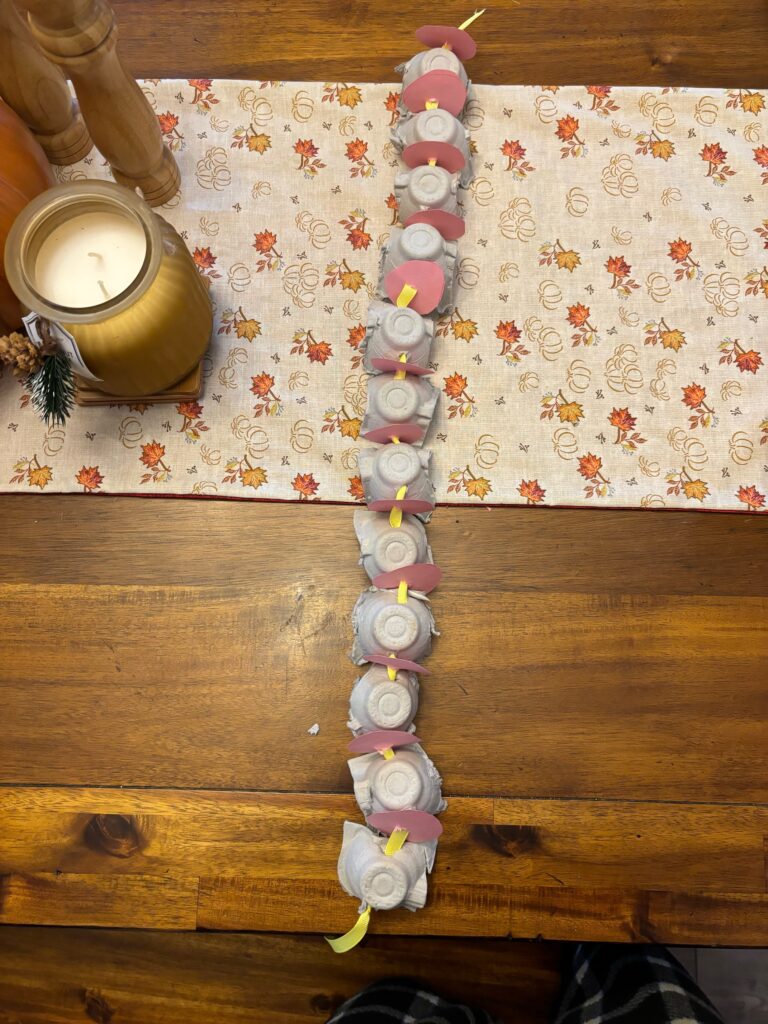

I am doing my STEAM project on scoliosis. I built the spine with egg cartons, construction paper, and ribbon. This project is aimed to show the potential progress of fixing scoliosis.
I will be talking about the type of scoliosis I have. I have mild scoliosis. This means I do not need surgery or any brace. I got scoliosis due to the increased muscle on my left side. The muscle is moving my spine, causing lower back and hip pain. My physical therapist showed me different exercises and treatments I should do to help with the pain. I need to increase the muscle on the right side of my back. He introduced me to different stretches and exercises during the first day of treatment. I was given a roller and different workout bands. I did what I was recommended for three weeks and noticed an apparent advancement. I suffered minor hip pain, and I had more mobility in my back and hip. During the second appointment, my therapist wanted to start more treatment. He decided to do cupping therapy. Cupping therapy has many purposes. In my situation, I used this treatment to increase the blood flow throughout my lower back muscles. It adds back circulation in the muscle. This relieves muscle tension, which causes my muscles to loosen. This allows my spine to start slowly shifting back to normal.
Many treatments include stretching, physical therapy, exercises, and surgery. Depending on the curve in the spine determines what the treatment will be. Monitoring usually occurs if the spine curve is less than 25 degrees. If the curve is between a 25-degree- and 45-degree angle, the patient will have a brace. Anything over 45 degrees requires surgery.
There are four types of scoliosis. Idiopathic is the most common type. There is no definite cause, but doctors assume it usually is related to genetics. Many Idiopathic cases do not usually require treatment besides monitoring. The signs of idiopathic scoliosis are uneven shoulders and waistline, more prominent ribs on a particular side, and differences in leg length/hip height. The second type of scoliosis is congenital. Congenital scoliosis is a birth defect that usually occurs in 1 out of 10,000 newborns. Most patients with congenital scoliosis have other defects, which include kidney and bladder problems. Comparable to idiopathic scoliosis, signs of congenital scoliosis are uneven shoulders and waistline and prominence of the ribs on one side of the spine. There have also been cases of spinal cord deformities and numbness of nerves. The third type of scoliosis is degenerative. Most patients with this type are adults. The cause of scoliosis in adults usually relates to osteoporosis, which means the bones become weak and brittle. Wear and tear occur on the spine. This causes lower back pain, leg pain, and uneven hips and shoulders. The last type of scoliosis is neuromuscular scoliosis. Other disorders usually cause this type of scoliosis. Cerebral palsy and spinal cord injuries are associated with neuromuscular scoliosis. The symptoms and signs are the same as congenital and idiopathic scoliosis. Spinal fusion surgery is the primary treatment for neuromuscular scoliosis.
- The exercises by physical therapist said to do
- MediLexicon International. (n.d.). Scoliosis: The best stretches and exercises. Medical News Today. https://www.medicalnewstoday.com/articles/325385
- Surgical Treatment for Scoliosis. OrthoInfo. (n.d.). https://orthoinfo.aaos.org/en/treatment/surgical-treatment-for-scoliosis/#:~:text=The%20operation%20for%20scoliosis%20is,able%20to%20improve%20curves%20significantly.
- The use of exercises in the treatment of scoliosis: An evidence-based … (n.d.). https://www.tandfonline.com/doi/abs/10.1080/0963828032000159202
- Maruyama, T., & Takeshita, K. (2008, April 18). Surgical treatment of scoliosis: A review of techniques currently applied – scoliosis and spinal disorders. SpringerLink. https://link.springer.com/article/10.1186/1748-7161-3-6
- Maruyama, T., & Takeshita, K. (2008, April 18). Surgical treatment of scoliosis: A review of techniques currently applied – scoliosis and spinal disorders. SpringerLink. https://link.springer.com/article/10.1186/1748-7161-3-6
- Idiopathic scoliosis. Idiopathic Scoliosis | Boston Children’s Hospital. (n.d.). https://www.childrenshospital.org/conditions/idiopathic-scoliosis#:~:text=Idiopathic%20scoliosis%20is%20one%20of,often%20as%20it%20affects%20boys.
- Congenital scoliosis – orthoinfo – aaos. OrthoInfo. (n.d.). https://orthoinfo.aaos.org/en/diseases–conditions/congenital-scoliosis/
- Neuromuscular scoliosis. Neuromuscular Scoliosis | Boston Children’s Hospital. (n.d.). https://www.childrenshospital.org/conditions/neuromuscular-scoliosis#:~:text=What%20is%20n euromuscular%20scoliosis%3F,bifida%2C%20and%20spinal%20cord%20injury.
- Adult degenerative scoliosis. Seattle, WA – Brain and Spine Surgery. (2020, October 29). https://seattleneuro.com/spinal-conditions/adult-degenerative-scoliosis/

Camryn’s STEAM project is on the process of fixing scoliosis. Scoliosis is the irregular curve of the spine. If the curve of the spine is less than 25 degrees, monitoring of the spine occurs, and if the curve is anywhere between a 25-degree angle and a 45-degree angle, the patient requires a brace. The patient requires surgery if the spine has a curvature over 45 degrees. There are four types of scoliosis: idiopathic, congenital, degenerative, and neuromuscular scoliosis. Idiopathic scoliosis is when the shoulders and waistline are uneven, there is a difference in the length of the legs or hip height, and the ribs are more prominent on one side of the body. Idiopathic scoliosis is caused by genetics and requires monitoring. Congenital scoliosis occurs when the patient has uneven shoulders, uneven waistline, and more prominent ribs on one side of the body. Congenital scoliosis is a genetic disability that only affects 1 out of 10,000 babies. Degenerative scoliosis has symptoms of lower back pain, leg pain, and uneven hips and shoulders. This type of scoliosis results from osteoporosis, where the bones become fragile. The weakness of the bones causes wear and tear on the spine. The final type of scoliosis is neuromuscular scoliosis, and the symptoms are uneven shoulders, uneven waistline, and more prominent ribs on one side of the body. Neuromuscular scoliosis requires spinal fusion surgery for treatment.